The biggest economic development project ever proposed for Richmond had an eventful but sometimes rocky 12 months in 2019, a year that saw the now-$1.5 billion Navy Hill plan finalized and formally submitted to City Council, initiating a months-long, multilayered review process that is set to continue into 2020.
The year started off with the unannounced closure of the aging Coliseum, a modernized replacement of which is the anchor of the plan pitched by NH District Corp. (NHDC), the group of Richmond corporate heavyweights led by Dominion Energy CEO Tom Farrell. Around the same time, Farrell was pitching the plan to area groups, including a gathering of commercial real estate brokers in January.
The closure left the fate of the nearly 50-year-old Coliseum in limbo, and sent events that would have been held there to other venues. Initial plans for Navy Hill had called for demolishing the Coliseum, and using its debris to fill and regrade the adjacent Leigh Street, but that part of the project has since been scrapped.
Meanwhile, the neighboring VA Bio+Tech Park is preparing for a new six-story building across Leigh Street. That project and others, such as VCU’s new College of Health Professions building and its under-construction adult outpatient facility, have prompted some to question whether the 10-block area that would make up Navy Hill would develop organically, without the arena-anchored plan.
Local developer Josh Bilder submitted an alternate plan to the city, but city officials dismissed it as falling short of the requirements and due date of the city’s initial request for proposals. NHDC was the RFP’s sole respondent.
As proposed, Navy Hill would replace the Coliseum with a larger, 17,500-seat arena that would anchor a redevelopment of a 10-block area beside it with new apartments and condos, office and retail buildings, a 541-room hotel to supplement the Greater Richmond Convention Center, a GRTC transfer center and other facilities. Renovations to the Blues Armory building also are planned.
The bulk of the new development would be funded by NH District Corp., which has committed to producing $900 million in private investment. The public portion of the project – the new arena – would be funded in large part through tax-increment financing (TIF), generated from real estate tax revenue from new development and increased assessments in a district proposed to span much of downtown.
Those revenues would go toward paying off bonds that the city would use to fund the arena, projected to cost $235 million.
The TIF and other financials surrounding the proposal have been a point of contention for City Council, which considered putting the plan to voters in a November referendum. That effort failed by a 5-3 vote after a public hearing that showed varying opinions on the project.
Around the same time, after months of relative quiet, the project pushed forward with applications filed for rezonings to accommodate the development, which continued to be drawn up in a downtown office space that now serves as ground zero for the project’s developers.
After months of negotiations, Mayor Levar Stoney formally presented the development plan and related documents, giving City Council its first look at the proposal – two years after BizSense broke the news about it.
The negotiated proposal revealed new aspects of the plan, including two new high-rise buildings planned south of Broad Street, beyond the initial 10-block project area. The documents also gave a glimpse into the project’s evolution and involvements from a number of Richmond businesses.
Now, the plan is in the hands of City Council, which has been reviewing the plan in meetings and appointed an advisory commission to do the same. Meanwhile, Navy Hill’s backers have continued a push to drum up public support through meetings and endorsements, some of which have drawn criticism.
What’s next:
2020 should bring decisions made on Navy Hill, though no firm timeline has been established. Council ended the year debating whether to hire a third-party firm to further review the proposal. Meanwhile, Navy Hill’s backers have scheduled more presentations for the first weeks of the year.
One decision that could be made may come from Dominion Energy, which has yet to announce whether it will go forward with plans to build a second downtown tower, despite preparations to implode the one it would replace. That decision looms large over Navy Hill, as both towers are within the proposed TIF district and would significantly contribute to paying off the bonds for the arena.
Meanwhile, less talk has surrounded the city’s previously preferred economic development project: a replacement of The Diamond baseball stadium. But discussions appear to be picking up.
City leaders and developers revisited the topic in a BizSense panel event this year, and meetings in recent months have touched on the property as part of a larger planning effort through the city’s Richmond 300 initiative. Observers have suggested the two projects may have commonalities and potential economies of scale. More talk on that topic could be on the way.
The biggest economic development project ever proposed for Richmond had an eventful but sometimes rocky 12 months in 2019, a year that saw the now-$1.5 billion Navy Hill plan finalized and formally submitted to City Council, initiating a months-long, multilayered review process that is set to continue into 2020.
The year started off with the unannounced closure of the aging Coliseum, a modernized replacement of which is the anchor of the plan pitched by NH District Corp. (NHDC), the group of Richmond corporate heavyweights led by Dominion Energy CEO Tom Farrell. Around the same time, Farrell was pitching the plan to area groups, including a gathering of commercial real estate brokers in January.
The closure left the fate of the nearly 50-year-old Coliseum in limbo, and sent events that would have been held there to other venues. Initial plans for Navy Hill had called for demolishing the Coliseum, and using its debris to fill and regrade the adjacent Leigh Street, but that part of the project has since been scrapped.
Meanwhile, the neighboring VA Bio+Tech Park is preparing for a new six-story building across Leigh Street. That project and others, such as VCU’s new College of Health Professions building and its under-construction adult outpatient facility, have prompted some to question whether the 10-block area that would make up Navy Hill would develop organically, without the arena-anchored plan.
Local developer Josh Bilder submitted an alternate plan to the city, but city officials dismissed it as falling short of the requirements and due date of the city’s initial request for proposals. NHDC was the RFP’s sole respondent.
As proposed, Navy Hill would replace the Coliseum with a larger, 17,500-seat arena that would anchor a redevelopment of a 10-block area beside it with new apartments and condos, office and retail buildings, a 541-room hotel to supplement the Greater Richmond Convention Center, a GRTC transfer center and other facilities. Renovations to the Blues Armory building also are planned.
The bulk of the new development would be funded by NH District Corp., which has committed to producing $900 million in private investment. The public portion of the project – the new arena – would be funded in large part through tax-increment financing (TIF), generated from real estate tax revenue from new development and increased assessments in a district proposed to span much of downtown.
Those revenues would go toward paying off bonds that the city would use to fund the arena, projected to cost $235 million.
The TIF and other financials surrounding the proposal have been a point of contention for City Council, which considered putting the plan to voters in a November referendum. That effort failed by a 5-3 vote after a public hearing that showed varying opinions on the project.
Around the same time, after months of relative quiet, the project pushed forward with applications filed for rezonings to accommodate the development, which continued to be drawn up in a downtown office space that now serves as ground zero for the project’s developers.
After months of negotiations, Mayor Levar Stoney formally presented the development plan and related documents, giving City Council its first look at the proposal – two years after BizSense broke the news about it.
The negotiated proposal revealed new aspects of the plan, including two new high-rise buildings planned south of Broad Street, beyond the initial 10-block project area. The documents also gave a glimpse into the project’s evolution and involvements from a number of Richmond businesses.
Now, the plan is in the hands of City Council, which has been reviewing the plan in meetings and appointed an advisory commission to do the same. Meanwhile, Navy Hill’s backers have continued a push to drum up public support through meetings and endorsements, some of which have drawn criticism.
What’s next:
2020 should bring decisions made on Navy Hill, though no firm timeline has been established. Council ended the year debating whether to hire a third-party firm to further review the proposal. Meanwhile, Navy Hill’s backers have scheduled more presentations for the first weeks of the year.
One decision that could be made may come from Dominion Energy, which has yet to announce whether it will go forward with plans to build a second downtown tower, despite preparations to implode the one it would replace. That decision looms large over Navy Hill, as both towers are within the proposed TIF district and would significantly contribute to paying off the bonds for the arena.
Meanwhile, less talk has surrounded the city’s previously preferred economic development project: a replacement of The Diamond baseball stadium. But discussions appear to be picking up.
City leaders and developers revisited the topic in a BizSense panel event this year, and meetings in recent months have touched on the property as part of a larger planning effort through the city’s Richmond 300 initiative. Observers have suggested the two projects may have commonalities and potential economies of scale. More talk on that topic could be on the way.
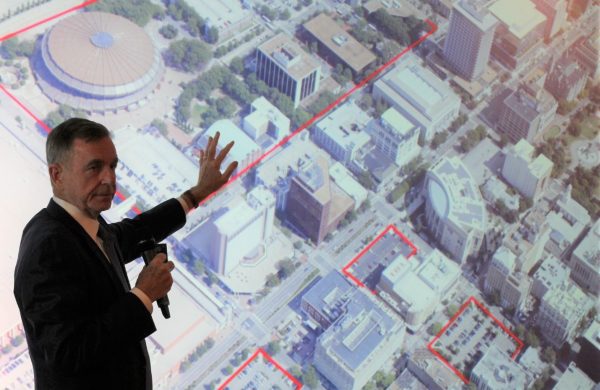
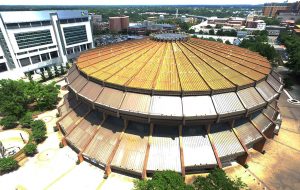
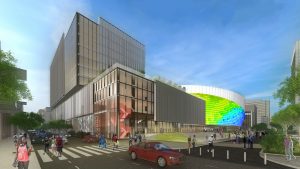
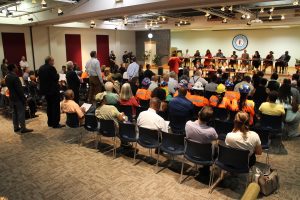
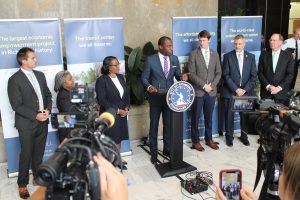
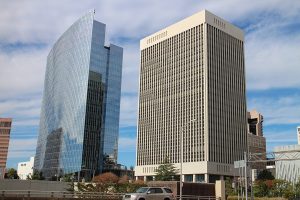
I do hope they can find a way to get this built that will make most people happy. I know not everyone will be but do think ultimately this would be good for Richmond
Wanting and needing are very different things. The price tag and the amount of tax money being given needs to be addressed. We want what’s best for our City, as residents of the City.
Wanting a shiny new development spearheaded by public/tax giveaways versus needing a shiny new development spearheaded by public/tax giveaways are very different things.
Our City leadership is holding organic development hostage as a result of cronyism being ripe and lucrative.
I agree though, let’s do something. But let’s do it organically.
Yes, you can be against the current Navy Hill proposal, and not be against development, not against a new stadium, and not against jobs growth.